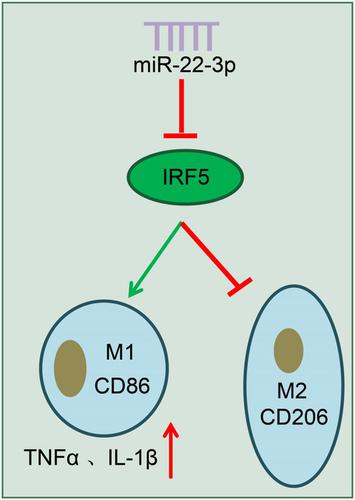当前位置:
X-MOL 学术
›
J. Neurochem.
›
论文详情
Our official English website, www.x-mol.net, welcomes your
feedback! (Note: you will need to create a separate account there.)
MicroRNA-22-3p alleviates spinal cord ischemia/reperfusion injury by modulating M2 macrophage polarization via IRF5.
Journal of Neurochemistry ( IF 4.2 ) Pub Date : 2020-05-14 , DOI: 10.1111/jnc.15042 Hua Fang 1, 2, 3 , Miao Yang 1, 2, 3 , Qin Pan 1, 2, 3 , Hon-Ling Jin 1, 2, 3 , Hua-Feng Li 4 , Ru-Rong Wang 5 , Quan-Yun Wang 5 , Jian-Ping Zhang 1, 2, 3
Journal of Neurochemistry ( IF 4.2 ) Pub Date : 2020-05-14 , DOI: 10.1111/jnc.15042 Hua Fang 1, 2, 3 , Miao Yang 1, 2, 3 , Qin Pan 1, 2, 3 , Hon-Ling Jin 1, 2, 3 , Hua-Feng Li 4 , Ru-Rong Wang 5 , Quan-Yun Wang 5 , Jian-Ping Zhang 1, 2, 3
Affiliation

|
Cell death after spinal cord ischemia/reperfusion (I/R) can occur through necrosis, apoptosis, and autophagy, resulting in changes to the immune environment. However, the molecular mechanism of this immune regulation is not clear. Accumulating evidence indicates that microRNAs (miRs) play a crucial role in the pathogenesis of spinal cord I/R injury. Here, we hypothesized miR‐22‐3p may be involved in spinal cord I/R injury by interacting with interferon regulatory factor (IRF) 5. Rat models of spinal cord I/R injury were established by 12‐min occlusion of the aortic arch followed by 48‐hr reperfusion, with L4‐6 segments of spinal cord tissues collected. MiR‐22‐3p agomir, a lentivirus‐delivered siRNA specific for IRF5, or a lentivirus expressing wild‐type IRF5 was injected intrathecally to rats with I/R injury to evaluate the effects of miR‐22‐3p and IRF5 on hindlimb motor function. Macrophages isolated from rats were treated with miR‐22‐3p mimic or siRNA specific for IRF5 to evaluate their effects on macrophage polarization. The levels of IL‐1β and TNF‐α in spinal cord tissues were detected by ELISA. miR‐22‐3p was down‐regulated, whereas IRF5 was up‐regulated in rat spinal cord tissues following I/R. IRF5 was a target gene of miR‐22‐3p and could be negatively regulated by miR‐22‐3p. Silencing IRF5 or over‐expressing miR‐22‐3p relieved inflammation, elevated Tarlov score, and reduced the degree of severity of spinal cord I/R injury. Increased miR‐22‐3p facilitated M2 polarization of macrophages and inhibited inflammation in tissues by inhibiting IRF5, thereby attenuating spinal cord I/R injury. Taken together, these results demonstrate that increased miR‐22‐3p can inhibit the progression of spinal cord I/R injury by repressing IRF5 in macrophages, highlighting the discovery of a promising new target for spinal cord I/R injury treatment.
中文翻译:

MicroRNA-22-3p通过通过IRF5调节M2巨噬细胞极化来减轻脊髓缺血/再灌注损伤。
脊髓缺血/再灌注(I / R)后的细胞死亡可能通过坏死,凋亡和自噬而发生,从而导致免疫环境的改变。但是,这种免疫调节的分子机制尚不清楚。越来越多的证据表明,microRNA(miRs)在脊髓I / R损伤的发病机理中起着至关重要的作用。在这里,我们假设miR-23-3p可能通过与干扰素调节因子(IRF)相互作用而参与了脊髓I / R损伤。5通过将主动脉弓闭塞12分钟建立了脊髓I / R损伤的大鼠模型随后进行48小时再灌注,进行L 4-6收集脊髓组织的各个部分。鞘内注射MiR-22-3pagomir,IRF5特异的慢病毒递送的siRNA或表达野生型IRF5的慢病毒,向I / R损伤大鼠鞘内注射,以评估miR-22-3p和IRF5对后肢运动功能的影响。从大鼠中分离出的巨噬细胞用针对IRF5的miR-22-3p模拟物或siRNA处理,以评估其对巨噬细胞极化的影响。ELISA法检测脊髓组织中IL-1β和TNF-α的水平。I / R后,大鼠脊髓组织中miR-22-3p的表达下调,而IRF5的表达上调。IRF5是miR-22-3p的靶基因,可能受miR-22-3p负调控。沉默IRF5或过表达miR-22-3p可减轻炎症,提高Tarlov评分并降低脊髓I / R损伤的严重程度。miR-22-3p的增加通过抑制IRF5促进了巨噬细胞的M2极化并抑制了组织中的炎症,从而减轻了脊髓I / R损伤。综上所述,这些结果表明,增加的miR-22-3p可以通过抑制巨噬细胞中的IRF5抑制脊髓I / R损伤的进展,突出了发现有希望的脊髓I / R损伤治疗新靶标的发现。
更新日期:2020-05-14
中文翻译:

MicroRNA-22-3p通过通过IRF5调节M2巨噬细胞极化来减轻脊髓缺血/再灌注损伤。
脊髓缺血/再灌注(I / R)后的细胞死亡可能通过坏死,凋亡和自噬而发生,从而导致免疫环境的改变。但是,这种免疫调节的分子机制尚不清楚。越来越多的证据表明,microRNA(miRs)在脊髓I / R损伤的发病机理中起着至关重要的作用。在这里,我们假设miR-23-3p可能通过与干扰素调节因子(IRF)相互作用而参与了脊髓I / R损伤。5通过将主动脉弓闭塞12分钟建立了脊髓I / R损伤的大鼠模型随后进行48小时再灌注,进行L 4-6收集脊髓组织的各个部分。鞘内注射MiR-22-3pagomir,IRF5特异的慢病毒递送的siRNA或表达野生型IRF5的慢病毒,向I / R损伤大鼠鞘内注射,以评估miR-22-3p和IRF5对后肢运动功能的影响。从大鼠中分离出的巨噬细胞用针对IRF5的miR-22-3p模拟物或siRNA处理,以评估其对巨噬细胞极化的影响。ELISA法检测脊髓组织中IL-1β和TNF-α的水平。I / R后,大鼠脊髓组织中miR-22-3p的表达下调,而IRF5的表达上调。IRF5是miR-22-3p的靶基因,可能受miR-22-3p负调控。沉默IRF5或过表达miR-22-3p可减轻炎症,提高Tarlov评分并降低脊髓I / R损伤的严重程度。miR-22-3p的增加通过抑制IRF5促进了巨噬细胞的M2极化并抑制了组织中的炎症,从而减轻了脊髓I / R损伤。综上所述,这些结果表明,增加的miR-22-3p可以通过抑制巨噬细胞中的IRF5抑制脊髓I / R损伤的进展,突出了发现有希望的脊髓I / R损伤治疗新靶标的发现。










































 京公网安备 11010802027423号
京公网安备 11010802027423号